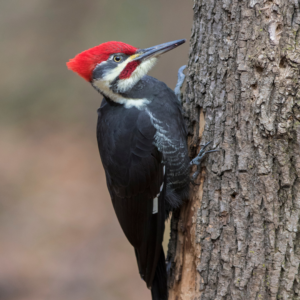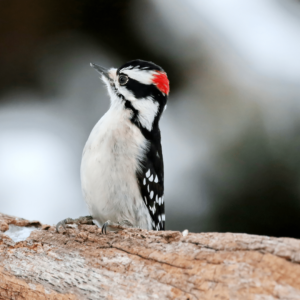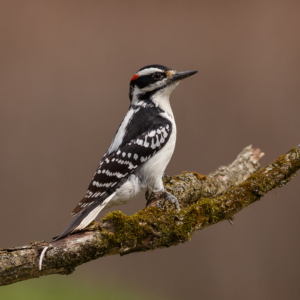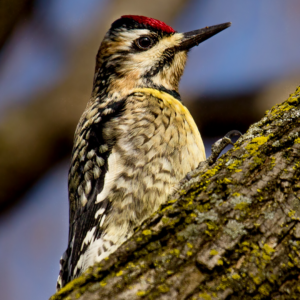-
Adopt
-
Veterinary Care
Services
Client Information
- What to Expect – Angell Boston
- Client Rights and Responsibilities
- Payments / Financial Assistance
- Pharmacy
- Client Policies
- Our Doctors
- Grief Support / Counseling
- Directions and Parking
- Helpful “How-to” Pet Care
Online Payments
Emergency: Boston
Emergency: Waltham
Poison Control Hotline
-
Programs & Resources
- Careers
-
Donate Now
There are 22 species of woodpeckers living in the United States, and 7 common to Massachusetts. Although each species has distinctive plumage markings and lives in a defined area, they share several characteristics. Woodpeckers have a chisel-like bill and a long, pointed tongue that they use to drill and probe under tree bark. They use their strong claws and tail feathers to help support them while they are working on tree trunks or branches. Their brains are protected from the impact of drilling by a thick skull and dust is filtered away from their nostrils by special sacs and feathers found around their nostrils.
Woodpeckers common to Massachusetts:
- Pileated woodpecker
- Red-headed woodpecker
- Red-bellied woodpecker
- Downy woodpecker
- Hairy woodpecker
- Northern flicker
- Yellow-bellied sapsucker
Most woodpeckers live in wooded areas and use their strong beaks to feed on insects living under the bark of dead trees. Depending on the species, they eat carpenter ants, beetles, moths, caterpillars, grasshoppers, nuts, fruit, berries, and tree sap. During the winter months, they can be seen feeding at bird feeders with suet and or sunflower seeds.
When it comes to building a nesting site, both the male and female woodpeckers use their beaks to excavate tree cavities. The eggs are laid in the spring and both parents care for the young.
POSSIBLE CONFLICTS & SOLUTIONS
Conflicts arise between homeowners and woodpeckers when the birds choose to focus their eating, drumming, and excavating efforts on buildings with wood siding, or on chimney pipes during mating season.
Woodpeckers mate and nest in the spring and consequently this is the time of year that most problems occur. The birds use rhythmic drumming on resonant objects as a territorial “advertisement” to alert other woodpeckers in the area to their presence. This persistent drumming activity results in shallow, clustered dents rather than the deeper holes that result from feeding and nesting activities.
A woodpecker’s nesting and roosting cavity is usually round and deep (up to two feet deep in trees) and is usually found in trees or in wood knots in wood siding. The most damaging woodpecker activity is caused when woodpeckers feed on insects under wood siding. It is understandable that some homeowners become upset when their wood siding is drilled with holes. Once a woodpecker finds a good food supply, they can be relentless in their feeding. Although this can cause a homeowner stress, it can also be viewed as an early warning sign that they have an insect infestation problem that should be addressed.
Woodpeckers can be persistent so the key to humanely and effectively resolving problems with woodpeckers is to act promptly. Remember that persistence and consistency are necessary to dissuade woodpeckers from causing damage.
The following are easy, cost-effective ways to prevent and repair woodpecker damage:
- Maintain the exterior of wooden buildings to prevent insect infestations.
- After making absolutely sure no birds are inside, fill shallow holes with caulking or wood filler, and larger holes with wooden plugs or wadded window screen, and then use caulking.
- Cover damaged areas with mesh hardware cloth or welded wire to protect them from further damage.
- Secure loose boards and use filling behind ones that sound hollow to discourage drumming.
The following are simple and humane harassment techniques that can encourage woodpeckers to move on:
- To exclude birds and discourage drumming, cover smaller boards with cloth or foam rubber padding.
- To prevent access to the wood siding, hang netting, plastic sheeting, or screen from the eaves and suspend it several inches from the affected wall.
- To scare away the offending woodpecker, hang aluminum pans, plastic streamers, wind chimes, Mylar® party balloons, or strips of aluminum foil from the eaves so that they flutter in the wind. In addition, shouting, clapping, or banging on a pot out an open window/door may scare the bird away. Click here to go to our links and resources page to find vendors that sell some of these products.
- To encourage woodpeckers to roost elsewhere, use roost inhibitors, distress call devices, predator-shaped kites, and scarecrows. Click here to go to our links and resources page to find vendors that sell these devices.
It is important to remember that nesting and roosting activities are temporary seasonal behaviors. If the woodpecker’s activity is not causing damage to a building, please try to exercise patience. If the bird is causing damage, please try the humane harassment techniques listed above to discourage them.
PUBLIC HEALTH CONCERNS
Woodpeckers are not considered to be a significant source for any infectious disease that can be transmitted to humans.
Learn more about woodpeckers in Massachusetts from Mass Audubon











